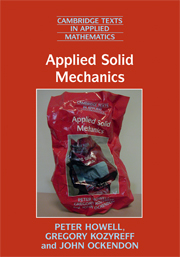Book contents
Prologue
Published online by Cambridge University Press: 02 February 2010
Summary
Although solid mechanics is a vitally important branch of applied mechanics, it is often less popular, at least among students, than its close relative, fluid mechanics. Several reasons can be advanced for this disparity, such as the prevalence of tensors in models for solids or the especial difficulty of handling nonlinearity. Perhaps the most daunting prospect for the student is the multitude of different behaviours that can occur and cause elementary theories of elasticity to become irrelevant in practice. Examples include fracture, buckling and plasticity, and these pose intellectual challenges in solid mechanics that are every bit as fascinating as concepts like flight, shock waves and turbulence in fluid dynamics. Our principal objective in this book is to demonstrate this fact to undergraduate and beginning graduate students.
We aim to give the subject as wide an accessibility as possible to mathematically- minded students and to emphasise the interesting mathematical issues that it raises. We do this by relating the theory to practical applications where surprising phenomena occur and where innovative mathematical methods are needed.
Our layout is essentially pragmatic. Although more advanced texts in solid mechanics often begin with quite general theories founded on basic mechanical and thermodynamic principles, we start from the very simplest models, based on elementary observations in engineering and physics, and build our way towards models that are the basis for current applied research in solid mechanics. Hence, we begin by deriving the basic Navier equations of linear elasticity, before illustrating the mathematical techniques that allow these equations to be solved in many different practically relevant situations, both static and dynamic.
- Type
- Chapter
- Information
- Applied Solid Mechanics , pp. xiii - xivPublisher: Cambridge University PressPrint publication year: 2008

